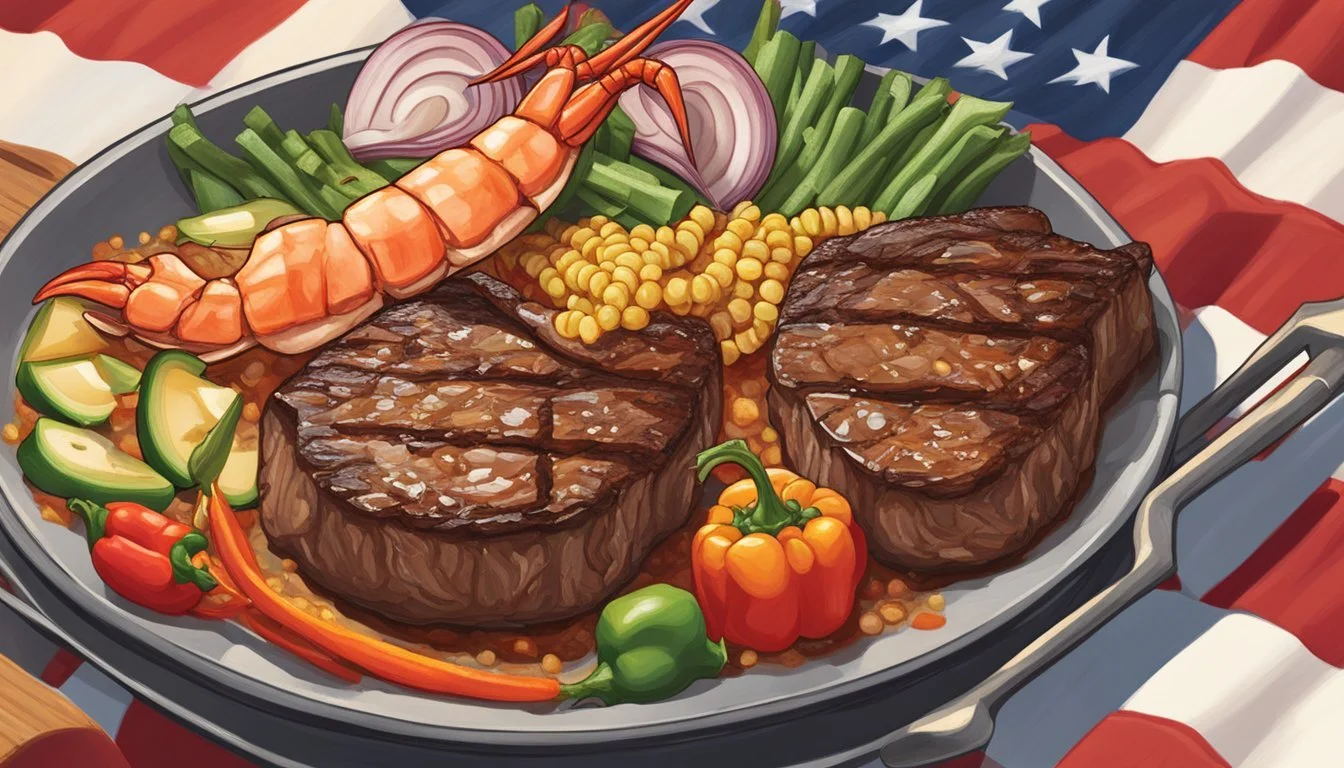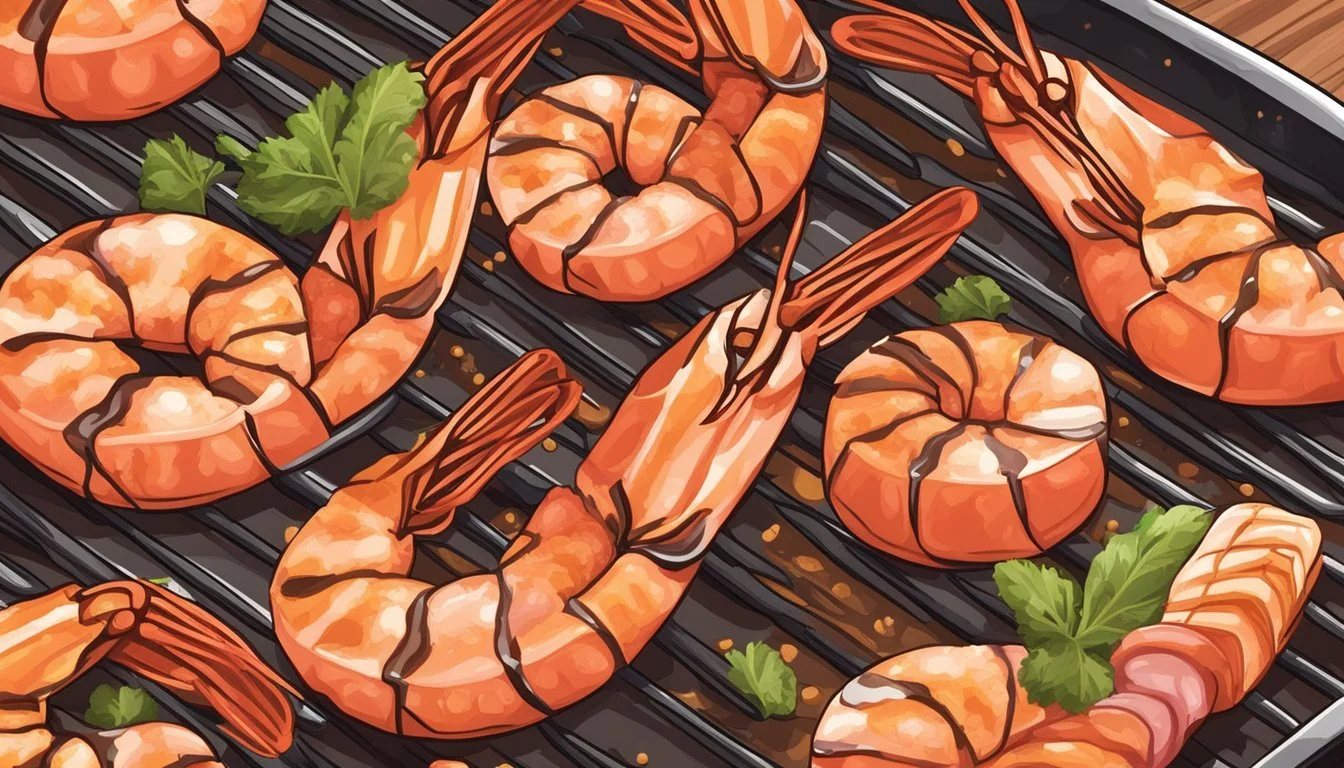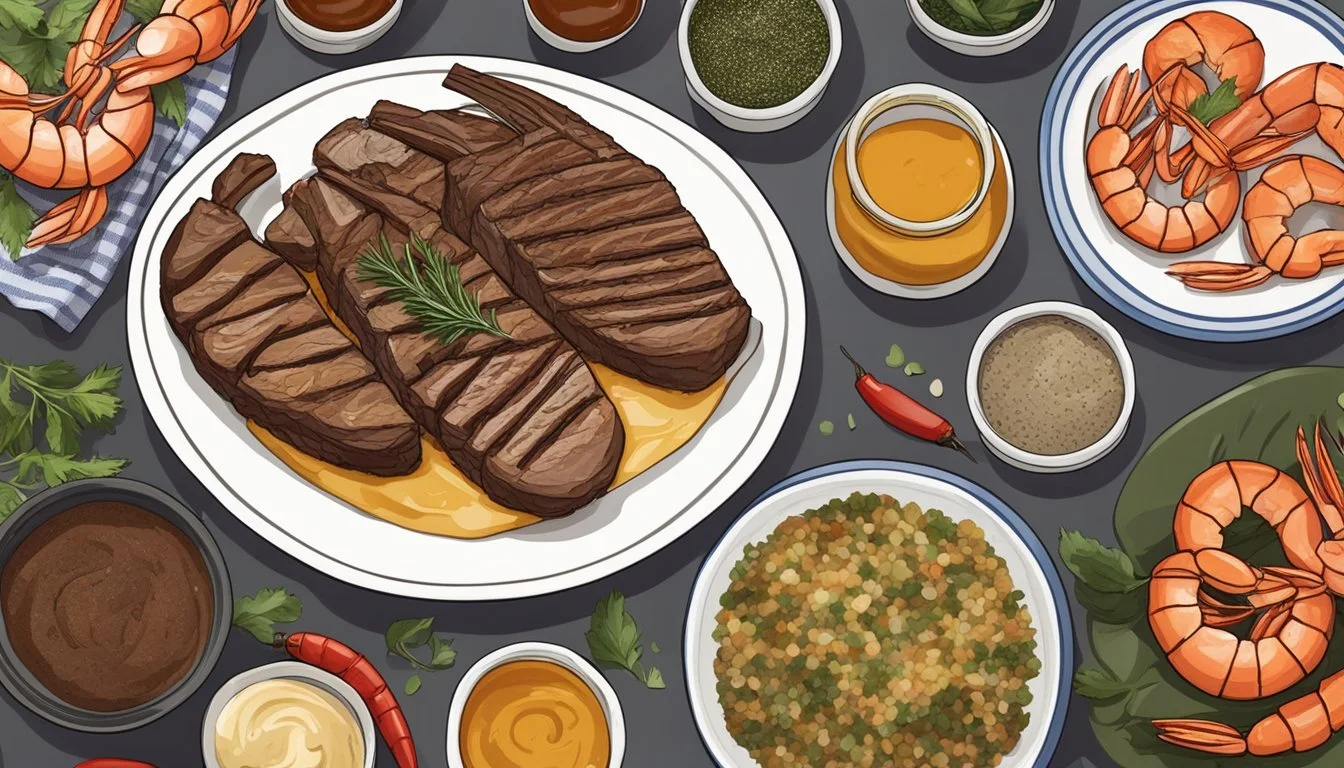How to Prepare a Texas-Style Surf and Turf
A Step-by-Step Culinary Guide
A classic surf and turf meal marries the fruits of the sea with the richness of land-based fare, symbolizing a harmony of flavors that has long tantalized the American palate. In Texas, this dish takes on a grander scale, reflecting the state’s reputation for bold flavors and hearty portions. The Texas-style surf and turf typically features a perfectly seared steak alongside succulent seafood, such as shrimp or lobster (What wine goes well with shrimp?), seasoned with a blend of spices that pay homage to the region’s love for heat and depth of flavor.
Preparing a Texas-style surf and turf requires attention to detail and timing, ensuring that both the surf and the turf are cooked to perfection. Steak might be seasoned with a simple yet robust mixture of garlic salt, black pepper, and perhaps a hint of smoked paprika to add an unexpected layer of flavor. Seafood (What wine goes well with seafood?), on the other hand, benefits from lighter seasoning to preserve its delicate taste, often enhanced with a touch of salt, black pepper, and a squeeze of fresh lemon juice right before it's cooked.
The cooking methods employed in Texas-style surf and turf focus on locking in these flavors and achieving a desirable texture for both components. For the turf, a high-heat sear in a cast-iron skillet is crucial, creating a crisp crust that encases a juicy, tender interior. The surf, whether it’s shrimp or scallops (What wine goes well with scallops?), is often cooked quickly over high heat or wrapped in bacon and roasted to strike the right balance between a crispy exterior and a moist, flavorful interior. The harmony of a well-executed surf and turf lies in the contrast of textures and the union of savory and briny flavors on the plate.
Selecting the Ingredients
The cornerstone of a Texas-style surf and turf lies in the quality of its steak and shrimp. Ensuring that both proteins are of high quality will set the tone for a rich and satisfying dish.
Choosing the Right Steak
When selecting steak for a surf and turf, one should look for top sirloin or flat iron steak as economical yet flavorful options. Top sirloin is well-regarded for its balance of tenderness and robust beef flavor. On the other hand, a flat iron cut offers a more tender texture and is well-suited for grilling. One should always opt for Prime, Choice, or Select grades to ensure a quality experience; with Prime being the highest quality, featuring the most marbling, Choice providing less marbling but still high quality, and Select offering a leaner option with minimal marbling.
Prime Grade: Abundant marbling; ideal for grilling.
Choice Grade: Moderate marbling; good for a balance of flavor and tenderness.
Select Grade: Modest marbling; budget-friendly without sacrificing quality.
Selecting Quality Shrimp
For the seafood component, one should aim for large shrimp, as their substantial size complements the steak, and they're easier to grill without overcooking. When purchasing shrimp, freshness is key. They should smell clean, akin to saltwater, without overpowering fishy odors. If available, wild-caught shrimp are typically preferred for their superior taste and texture. The shrimp must be deveined and can be bought either with shells on, which can enhance flavor during cooking, or shelled for convenience.
Key indicators of quality shrimp:
Size: Aim for large shrimp for the best pairing with steak.
Odor: A mild, clean, and fresh smell, similar to the ocean.
Source: Wild-caught shrimp are preferable for taste and texture.
Preparing the Steak
When preparing a Texas-Style Surf and Turf, the steak is just as important as the seafood. Achieving the perfect flavor and doneness requires attention to seasoning, as well as the method of cooking, whether it’s done indoors in a skillet or outdoors on a grill.
Seasoning the Steak
One should begin by combining garlic salt, black pepper, and paprika in equal proportions to create a robust seasoning blend. Before seasoning, one must lightly coat the steak with olive oil, about a teaspoon on each side, ensuring an even distribution of the seasoning mixture onto the meat.
Ingredients for Steak Seasoning:
1 teaspoon of garlic salt
1 teaspoon of ground black pepper
1 teaspoon of paprika
Olive oil for coating
Cooking Steak Indoors
For indoor cooking, one should heat a cast iron skillet over medium to high heat. Before placing the steak in the skillet, they must pat the steak dry to ensure proper browning. Cook the steak to the desired level of doneness, turning once. An instant-read thermometer can be used to check the internal temperature, looking for a reading of 135°F (57°C) for medium-rare.
Steps for Indoor Cooking:
Heat cast iron skillet on medium-high.
Dry steak and cook in skillet, turning once.
Use an instant-read thermometer to check for 135°F for medium-rare.
Grilling Steak Outdoors
When grilling outdoors, one should prepare a charcoal grill for direct, high heat. The grill must be hot before the steak is placed to achieve a well-seared crust. One must also let the steak rest for a few minutes after grilling to let the juices redistribute, ensuring a moist cut. Again, use an instant-read thermometer to gauge the doneness, aiming for that internal temperature of 135°F (57°C) for medium-rare.
Steps for Outdoor Grilling:
Preheat charcoal grill to high heat.
Grill steak, turning once for even cooking.
Rest steak post-grill before serving.
Check doneness with instant-read thermometer at 135°F for medium-rare.
Each method imparts a different flavor and texture, but both should result in a steak that is cooked to the diner's preference, richly seasoned, and ready to be paired with the chosen seafood for a classic Texas-Style Surf and Turf experience.
Preparing the Shrimp
In crafting a Texas-style Surf and Turf, preparing the shrimp is just as important as the steak selection. This section outlines how to devein and clean the shrimp, marinate them for optimal flavor, and cook them to perfection.
Deveining and Cleaning
Properly cleaning shrimp is essential to ensure a good dining experience. To begin, one needs to remove the shell and the vein that runs along the back of the shrimp. This can be done by making a shallow cut along the back and pulling out the dark vein. Next, rinse the shrimp under cold water to eliminate any residual debris.
Marinating the Shrimp
The secret to flavorful shrimp lies in a robust marinade. For a Texas-style zing, one should whisk together olive oil, freshly squeezed lemon juice, and finely minced garlic cloves. Submerge the shrimp in this mixture and let them marinate for about 15 to 30 minutes; this will infuse them with a vibrant, garlicky flavor that complements the boldness of Texas cuisine.
1/4 cup of olive oil
2 garlic cloves, minced
Juice of 1 lemon
Cooking the Shrimp
When it comes to cooking, one can use a grill pan or skillet to achieve a delectable sear on the shrimp. Heat the pan over a medium-high flame until it's hot. Cook the shrimp for 1 to 2 minutes on each side or until they turn pink and opaque. It's important not to overcook them, as they can quickly become tough and rubbery. The high heat will impart a slight char, which provides a lovely textural contrast to the shrimp's natural tenderness.
Complementary Sides
Selecting the perfect side dishes is crucial to enhancing the overall Texas-style surf and turf experience. They should balance the richness of the meat and the delicacy of the seafood, utilizing fresh ingredients and robust flavors.
Vegetables for Grill or Skillet
Grilled or skillet-cooked vegetables (how long do cooked vegetables last?) offer a smoky richness or a seared crispness that pairs excellently with surf and turf. Asparagus (how long does asparagus last?), for instance, can be grilled with a drizzle of olive oil and a sprinkle of freshly cracked pepper, achieving a tender yet slightly charred texture. Similarly, sliced mushrooms and a blend of colored bell peppers, including red and yellow pepper, can be sautéed in a skillet to bring out their natural sweetness, which complements the savory flavors of the dish.
Grilled Asparagus (What wine goes well with grilled asparagus?) :
Fresh asparagus spears
Olive oil
Freshly cracked pepper
Skillet-Cooked Veggies:
Sliced mushrooms
Red and yellow peppers
Olive oil
Salt to taste
Crafting the Perfect Paella
Paella, a splendid rice dish with saffron-infused flavors, is an exceptional side that captures the essence of both land and sea. Start by sautéing a yellow onion before adding bomba rice and fire-roasted diced tomatoes. Layering in sweet peas and a variety of seafood can mirror the coastal elements of surf and turf, while a rich beef broth deepens the overall taste. As the paella cooks, a coveted socarrat—the crispy crust on the bottom of the paella pan—forms, providing a textural contrast. Garnish with flat-leaf parsley leaves and serve with lime wedges for an added zing.
Bold Paella Components:
Bomba rice
Saffron
Fire-roasted diced tomatoes
Beef broth
Yellow onion, sweet peas, red and yellow peppers
Freshly cracked pepper
Garnish: Flat-leaf parsley leaves, lime wedges
In serving these side dishes alongside a Texas-style surf and turf, one achieves a satisfying meal that is both well-rounded and true to the region's bold culinary spirit.
Seasonings and Condiments
A Texas-style surf and turf meal harmonizes the flavors of the sea and the ranch with a robust selection of seasonings and condiments. The foundation of this flavorful dish includes salt and black pepper. For the perfect seasoning balance, one can utilize both sea salt and freshly ground black pepper to enhance the taste of the meat and seafood.
Garlic and onion play pivotal roles in the seasoning mix, lending their aromatic qualities to the dish. They are often finely chopped or minced to ensure their flavors are well distributed. A drizzle of high-quality olive oil not only facilitates cooking but also brings a subtle, fruity note that complements the richness of both the steak and the seafood.
For a touch of green and a fresh flavor, parsley is a classic herb in Texan kitchens, either finely chopped or as a garnish. To bring out the gourmet flair, chefs may sprinkle a few saffron threads over the seafood, offering a luxurious color and an exotic taste.
Lemon wedges offer a bright, citrusy counterpoint that can cut through the fatty richness of steak and elevate the delicate seafood. A dash of smoked sweet paprika can add a hint of smoky depth, especially when applied to the steak before grilling.
In the context of Texas surf and turf, Valencia, a region known for its premium spices, could inspire the use of high-quality ingredients like smoked paprika or saffron to provide authenticity in flavor. It’s essential, however, not to overpower the inherent tastes of the high-quality steak and fresh seafood.
Here is a quick reference for the seasonings and condiments:
Ingredient Use Case Salt To enhance the meat and seafood flavors. Freshly Ground Black Pepper For a robust, piquant kick. Garlic Minced for aromatic depth. Onion Finely chopped for savory notes. Olive Oil For cooking and a fruity note. Parsley Chopped for freshness and garnish. Saffron Threads For a touch of luxury and color in seafood. Lemon Wedges To add brightness and cut richness. Smoked Sweet Paprika For a smoky depth on steak.
In preparing the seasonings, chefs should aim for balance, allowing each element to complement the others without one overwhelming the rest. This ensures a harmonious Texas-style surf and turf experience.
Plating and Presentation
When presenting Texas-style Surf and Turf, attention to detail is essential to enhance both visual appeal and flavor. Begin with a warm plate to help ensure the food remains at an optimal temperature. The steak is typically the centerpiece of the dish, so it should be placed prominently on the plate.
For a visually balanced plate, position the steak slightly off-center, allowing room for the seafood component. The lobster or other seafood should be strategically placed to complement the steak's appearance. If using lobster tails, consider cutting them lengthwise and resting them with the cut side up to reveal the succulent meat.
Garnishing with flat-leaf parsley provides not only a pop of color but also a fresh, herbaceous note that contrasts well with the rich proteins. Place a small sprig on top of the steak or beside it on the plate.
A wedge of lemon serves as both a garnish and a flavor enhancer. Include a couple of lemon wedges on the side of the plate for guests to use at their discretion; the citrus acidity cuts through the richness of the steak and lobster, brightening the overall taste.
Finally, ensure the steak and seafood are not overcrowded on the plate, allowing each element to stand out. The visual presentation should be clean and simple, showcasing the quality of the ingredients and the care taken in preparation.
Safety and Cooking Tips
When preparing Texas-style surf and turf, safety in handling and cooking is crucial to ensure a delicious and healthy meal. It is important to consider the cooking surfaces and tools, as well as the internal temperature of the meats to be cooked.
High Heat: Both steak and seafood benefit from cooking at high temperatures. When using a cast iron skillet, one should heat it until it is very hot before adding oil. This technique helps to create a well-seared crust on the steak.
Grill Safety: If opting for a grill to cook steak or seafood, ensure that it's clean and preheated. Keep a safe distance from the grill to avoid burns and use long-handled tools to manage the food.
Nonstick Skillet Caution: While nonstick skillets are easier to handle, they should not be used over high heat, as they can release harmful fumes. Reserve nonstick skillets for cooking at lower temperatures.
Internal Temperature: An instant-read thermometer is an invaluable tool. For steak, medium-rare is typically targeted at an internal temperature of 130°F to 135°F. Seafood, such as shrimp, should be cooked until opaque and firm.
Health Precaution: Ensure all meats are stored at safe temperatures prior to cooking to prevent the growth of harmful bacteria. Seafood in particular should be kept on ice or in the refrigerator until it's time to cook.
Using accurate nutrition information is beneficial for dietary considerations. Pay attention to portion sizes, and be aware of the oil and butter used in cooking, as they contribute to the overall caloric and fat content of the meal.
Lastly, always keep a kitchen fire extinguisher within reach, as cooking with oils at high temperatures can pose a risk of igniting. With these tips in mind, one can cook with confidence, ensuring a safe and delectable Texas-style surf and turf experience.
Conclusion
Preparing a Texas-style surf and turf can lead to an enjoyable and decadent meal, showcasing the best of both sea and land. Careful preparation of the steak is crucial: one must season it properly and achieve a high-quality sear to lock in flavors. Pairing with seafood demands equal attention to ensure that dishes such as garlic shrimp or seasoned lobster tails complement the hearty flavors of the beef.
In terms of nutrition, surf and turf can deliver a substantial amount of protein from both the meat and seafood components. However, mindful portion sizes and balanced seasoning can help manage caloric intake and sodium levels.
When serving, present the surf and turf on a pre-heated plate to maintain the temperature. Fresh sides can include a light salad or steamed vegetables, keeping attention on the main components. This meal is often reserved for special occasions, and the presentation should thus mirror the significance of the event.
For those concerned with nutrition, considering leaner cuts of steak and incorporating more seafood, which is typically lower in fat than red meat, can be beneficial. Grilling or broiling are preferred methods for cooking to reduce added fats.
A successful Texas-style surf and turf is about harmony between the robust flavors of beef and the delicate tastes of seafood. When prepared thoughtfully, it encapsulates a rich culinary tradition that continues to be beloved in Texas and beyond.








